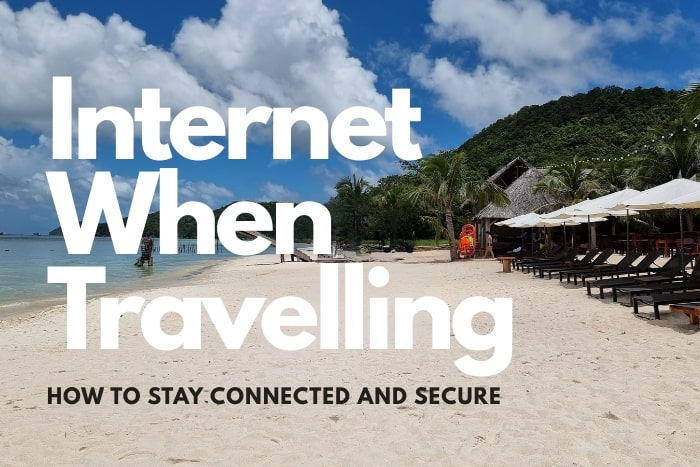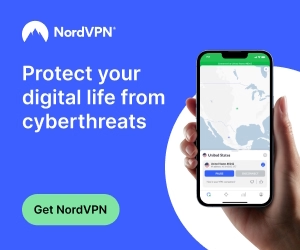When you’re travelling, internet access can be just as important as your passport. From booking hotels and rideshares to navigating new cities and keeping in touch with family, most of us can’t imagine exploring the world without being online.
But staying connected abroad isn’t always straightforward or safe. Years ago while travelling through Asia, we had our credit card hacked after using public WiFi. It was a stressful experience that taught us the hard way just how vulnerable your data can be when travelling. Since then, we’ve made online security a top priority by always using a VPN and setting it to connect automatically on all our devices.

These days, we also rely on eSIMs to keep our phones connected. They let us know the cost upfront, so there are no nasty roaming surprises when we get home. Between secure connections and predictable data plans, we’ve finally found a system that keeps us safe, connected, and stress-free while travelling.
In this guide, we’ll share the best ways to get internet when travelling, along with practical tips to stay secure online, so you can explore the world with confidence.

Why Internet Access is Essential When Travelling
Travel today looks very different from a decade ago. Back then, guidebooks and paper maps were the norm. Now, the internet is our compass, our planner, and often our safety net.
Here are just a few ways internet access plays a vital role when you are on the road:
- Navigation and transport – Whether it is following Google Maps through a busy city or booking a Grab, Uber, or local taxi app, reliable data makes getting around much easier.
- Accommodation and bookings – From last minute hotel reservations to changing a flight, having an internet connection keeps your travel plans flexible.
- Communication – Most travellers rely on WhatsApp, Messenger, or FaceTime instead of traditional calls. These apps only work with data or WiFi, making internet access essential.
- Money management – Online banking and payment apps are a lifeline for paying bills, transferring money, and avoiding foreign transaction surprises.
- Travel research on the go – Want to find a restaurant nearby or check opening hours for a museum? A quick search saves wasted time and missed opportunities.
For us, the first thing we do when arriving in a new country is make sure we have a reliable connection. Having internet on hand gives peace of mind and allows you to focus on enjoying the journey instead of stressing about logistics.
How to Get Internet While Travelling
There are a few main ways to stay connected when travelling, each with its own pros and cons. Choosing the right option depends on your budget, travel style, and how much data you really need.

Local SIM Cards
Buying a local SIM card used to be the go-to solution. It can be cheap, especially if you are staying in one country for a longer time. The downside is the hassle of finding a provider when you arrive, often in a busy airport when all you want to do is get to your hotel. Add to that the language barrier and you can end up wasting precious holiday time.
International Roaming
Most mobile providers offer international roaming packages, but they can be expensive. We avoid this option as roaming charges add up quickly and you can easily return home to a shock bill.
eSIMs
These days we always use an eSIM. It can be purchased online before you leave, activated as soon as you land, and you are instantly connected. There is no need to fumble with tiny SIM cards or hunt down a shop in a new city. We also like knowing exactly what the data will cost us upfront, which helps avoid roaming surprises.
Check here for discount pricing on the eSim we use and recommend
Portable WiFi Devices
Some travellers prefer portable WiFi hotspots, sometimes called “pocket WiFi”. These devices can connect multiple devices at once, which is handy if you are travelling as a family. However, they often require a deposit, need charging, and can be one more thing to keep track of in your luggage.
Free Public WiFi
Airports, cafés, and hotels often offer free WiFi, which can be convenient. But it comes with serious risks if you are not protecting your connection. We will cover this in detail later, but our rule is simple: never use public WiFi without a VPN.

Staying Secure Online While Travelling
Getting online is only half the story. Staying safe while connected is just as important. Public networks are often unprotected, making it easy for hackers to intercept your data. Unfortunately, we learned this the hard way when our credit card details were stolen in Asia after connecting to unsecured WiFi.
Since then, we have changed the way we travel online. Here are our top tips for keeping your connection safe:
- Always use a VPN – A virtual private network (VPN) encrypts your data and hides your browsing activity from prying eyes. We use NordVPN on all our devices and have it set to connect automatically whenever we join public WiFi. This way, we never forget to turn it on.
- Avoid sensitive transactions on public WiFi – Try not to log in to your bank or make purchases on hotel or café WiFi unless you are protected by a VPN.
- Check for HTTPS websites – When entering personal details, make sure the website starts with “https://”. The “s” stands for secure and offers an extra layer of protection.
- Keep devices updated – Software updates often include security patches. Make sure your phone, tablet, and laptop are up to date before and during your trip.
- Use two-factor authentication – For accounts like email or banking, add two-factor authentication. Even if your password is stolen, this extra step keeps hackers out.

We now treat online safety as part of travel planning, just like booking flights or packing bags. Taking a few precautions helps avoid stressful situations and keeps your information safe wherever you go.
Check here for the VPN we use and recommend
eSIM for Travel – Your Best Option
Of all the ways to get internet when travelling, eSIMs have quickly become our favourite. They are simple, affordable, and incredibly convenient.
An eSIM is a digital version of a SIM card that is already built into many modern smartphones. Instead of swapping tiny plastic cards, you can purchase a data plan online and activate it with just a few taps.

Here’s why we always choose eSIMs now:
- Set up before you fly – Buy and install your plan at home, then switch it on the moment you land.
- No hunting for SIM vendors – Skip the queues at the airport and the hassle of language barriers.
- Clear costs – Know exactly what you are paying upfront, with no surprise roaming bills when you return home.
- Easy top ups – If you run out of data, you can quickly add more through the provider’s app or website.
- Safe and reliable – Using your own mobile data means you are not relying on public WiFi networks, which are often unsecured.
Most newer phones support eSIM technology, and if you’re new to the concept, our international eSIM for travel guide walks you through everything you need to know.
Click here for eSim pricing and reviews
VPN for Travel – Must-Have Security
If there is one tool every traveller should have, it is a VPN. A virtual private network creates a secure, encrypted tunnel between your device and the internet. This means hackers, snoopers, and even unsecured WiFi providers cannot see your data.
We never travel without our VPN. After being hacked on a trip years ago, we started using NordVPN on all our devices and set it to auto-connect whenever we join a WiFi network. This simple step gives us peace of mind whether we are in an airport lounge, hotel, or café.

Here are the main reasons to use a VPN when travelling:
- Security on public WiFi – Protects sensitive information like credit card details, passwords, and emails.
- Privacy – Stops websites, advertisers, or governments from tracking your online activity.
- Access to content – Lets you access services from home that may be restricted overseas, such as streaming platforms or certain websites.
- Consistency – Keeps your connection stable by avoiding some regional restrictions.
For us, the convenience of setting the VPN to connect automatically means we never have to remember to switch it on, and it has become as important as the other safety tips for Australians travelling abroad.
Using Public WiFi Safely
Public WiFi can be a lifesaver when travelling, but it also comes with the highest risks. Airports, cafés, and hotels all offer free connections, yet these networks are often unsecured and easy targets for hackers.

We still use public WiFi at times, but only with safeguards in place. Here are our rules for staying safe:
- Never connect without a VPN – This is non-negotiable for us after having our credit card hacked. NordVPN now runs in the background on all our devices, giving us instant protection.
- Limit what you do online – Public WiFi is fine for checking maps or reading the news, but we avoid logging in to bank accounts or making online purchases unless necessary.
- Forget the network after use – Once you leave, remove the WiFi connection from your device so it does not reconnect automatically later without protection.
- Use mobile data when possible – If the task involves personal or financial information, we prefer using our eSIM data plan over public WiFi.
Public WiFi is convenient, but with the right precautions, it does not need to be dangerous, especially if you’re planning staying connected while enjoying long-term travel.

Final Tips for Internet When Travelling
After years of trial and error, we have learned that a little preparation goes a long way when it comes to staying connected. Here are some final tips we always follow:
- Download offline tools – Save maps, translation apps, and key travel documents before you go. They can be a lifesaver if you lose signal.
- Carry a power bank – Using your phone as a hotspot or relying on data drains the battery fast. A backup charger keeps you online longer.
- Check your plan before you leave – Make sure your phone supports eSIMs or is unlocked for international SIM cards.
- Keep an eye on data use – Track your usage in the provider’s app so you do not run out mid-trip.
- Mix WiFi and data wisely – Use public WiFi for casual browsing and save your mobile data for more secure tasks.
For us, the combination of an eSIM and a reliable VPN has become non-negotiable. It means we know what our data will cost, and we can stay secure no matter where we log on. With these systems in place, you can explore freely without worrying about online risks, and even pair them with budget-friendly travel savings to make your adventures go further.
Check here for discounted pricing on NordVPN plans
Final Words on Internet When Travelling
Staying connected when travelling is no longer a luxury, it is a necessity. From navigating new cities to staying in touch with loved ones, reliable internet access makes every trip smoother. But with convenience comes risk, and after experiencing credit card fraud ourselves, we learned the importance of taking online security seriously.
These days, our setup is simple. We rely on eSIMs for affordable and predictable data, and we never go online without a VPN running in the background. Together, they give us peace of mind that we can enjoy our travels without worrying about surprise bills or online threats.
With the right tools and habits, you can keep your connection safe too. Plan ahead, protect your data, and you will find that internet when travelling can be stress free.
